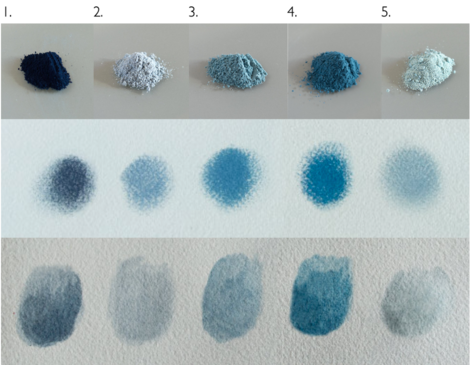Robert Wróblewski
Maya blue is the name for a blue color and a pigment that was used by the Mayans for religious purposes. Maya blue consists of the mineral palygorskite, which is dyed with indigo and bound with copal, a tree resin, through heating. It is extremely resistant to weathering and heat, as well as acids and alkalis. The recipe for its production was forgotten in the course of the 18th and 19th centuries. This colorant was rediscovered in 1931 on a wall painting in the temple city of Chichén Itzá in Mexico.
The ancient production process, which comes from the Mayan culture, gives us colors that complement the small color palette of blue vegetable dyes. Pure indigo from Indigofera tinctoria always produces black-blue tones. After mixing with attapulgite and heating, the blue is much purer. The processes are not very complicated: no special laboratory equipment is needed and no toxic chemical substances are used. The cost of the materials is low. In principle, it could easily be produced by artists or in chemistry lessons at schools.
The first production method, in which the pigment is only mixed with attapulgite, results in a different blue than the second method. Coats of this blue paint do not hold up as well as with the second method. However, this blue can still be used well in school lessons or for art therapy. Mixing with copal produces a different shade with stronger lightfastness.
The second method produces a turquoise blue that is comparable to the blue in works of art from the Mayan culture. The pigment is much more resistant. In addition to indigo and attapulgite, soda and sodium dithionite are required for production. Sodium dithionite must be handled with care.
This research was supported by the Foundation for Research Promotion of the Anthroposophical Society in Germany.
Or via Bank Transfer:
| CHF | EUR | |
| Allgemeine Anthroposophische Gesellschaft Postfach, 4143 Dornach/Schweiz Raiffeisenbank Dornach, CH–4143 Dornach BIC: RAIFCH22 IBAN: CH54 8080 8001 1975 4658 2 ⇨ Payment Purpose: KST 1118 | Allgemeine Anthroposophische Gesellschaft Postfach, 4143 Dornach/Schweiz GLS Gemeinschaftsbank eG, DE-44708 Bochum BIC: GENODEM1GLS IBAN: DE53 4306 0967 0000 9881 00 ⇨ Payment Purpose: KST 1118 |
